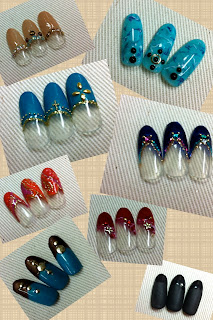it's "Time flies like an arrow" and sometime my friend say "Time is nothing" ....am i o..k....
This time , I'd like to show you some Japanese New Year★scene.
I think Japanese new year time is staying "Japanese traditional "time in a year.
We have many events this month, and also our Nails salon was busy time.
Japanese ladies wants to spend new years time with Beautiful Nail♪
 Years are traditionally viewed as completely separate, with each new year providing a fresh start. Consequently, all duties are supposed to be completed by the end of the year, while bonenkai parties ("year forgetting parties") are held with the purpose of leaving the old year's worries and troubles behind.
Years are traditionally viewed as completely separate, with each new year providing a fresh start. Consequently, all duties are supposed to be completed by the end of the year, while bonenkai parties ("year forgetting parties") are held with the purpose of leaving the old year's worries and troubles behind.Homes and entrance gates are decorated with ornaments made of pine, bamboo andplum trees, and clothes and houses are cleaned.
On New Year's eve, toshikoshi soba (buckwheat noodles), symbolizing longevity, are served. A more recent custom is watching the music show "kohaku uta gassen", a highly popular television program featuring many of Japan's most famous J-pop and enka singers in spectacular performances.
 |
| He is my friend who is teaching English in Osaka we spend time in New years Eve. |
 January 1 is a very auspicious day, best started by viewing the new year's first sunrise (hatsu-hinode), and traditionally believed to be representative for the whole year that has just commenced. Therefore, the day is supposed be full of joy and free of stress and anger, while everything should be clean and no work should be done.
January 1 is a very auspicious day, best started by viewing the new year's first sunrise (hatsu-hinode), and traditionally believed to be representative for the whole year that has just commenced. Therefore, the day is supposed be full of joy and free of stress and anger, while everything should be clean and no work should be done.It is a tradition to visit a shrine or temple during shogatsu (hatsumode). The most popular temples and shrines, such as Tokyo's Meiji Shrine, attract several million people during the three days. Most impressive are such visits at the actual turn of the year, when large temple bells are rung at midnight.
Various kinds of special dishes are served during shogatsu. They include osechi ryori, otoso (sweetened rice wine) and ozoni (a soup with mochi). |
| My Painting for his School |
After "Shogatu" We have another Event, for 20 years old♪
The second Monday of January is "Seijin no hi" (Coming-of-age Day) in Japan. People celebrate this day to welcome the young men and women, who have turned or will turn the age of 20 during the current year, as new members of society!! Ceremonies are held in every city, town and village. The people who have reached the age of twenty get the right to vote and also allowed to smoke and drink.

my Nails Salon's guest also so Beautiful!!
I did it, Long time ago..... w
and, also we have another Shrines need to visit for Business God !! "Ebisu san"
is one of "Seven Gods of Good Fortune"
The Seven Gods of Fortune (七福神, Shichi Fukujin), commonly referred to in English as the Seven Lucky Gods, refer to the seven gods of good fortune in the Shintō religion, Japanese mythology, and folklore. They are often the subject of netsuke carvings and other representations.
Each has a traditional attribute:
☆Ebisu, god of fishers or merchants, often depicted carrying a cod or sea bass.
★Daikokuten (Daikoku), god of wealth, commerce and trade. Ebisu and Daikoku are often paired and represented as carvings or masks on the walls of small retail shops.
☆Bishamonten, god of warriors.
★Benzaiten (Benten-sama), goddess of knowledge, art and beauty,especially Music.
☆Fukurokuju, god of happiness, wealth and longevity.
★Hotei, the fat and happy god of abundance and good health.
☆Jurōjin (Gama), god of longevity
I like all of that very Japanese month,
 and I felt Japanese ladies really care about Nails for that season.
and I felt Japanese ladies really care about Nails for that season.I did many design with Gel nails for Happy New year.
This is Gel nails show time ★
at Nail salon "Candy" at Namba Osaka.
and my private Nails&Foot Salon "Garret"
I have many photos, but next time more!!
I could't write this time
coz, too many...w
next time , i'd like to show you
more Nails photos and another event!!
soon
Thank you for visit !!
Naoe★















































